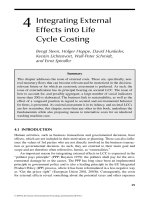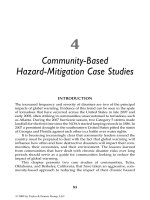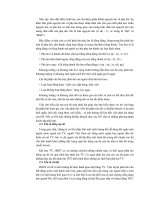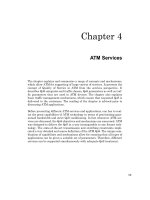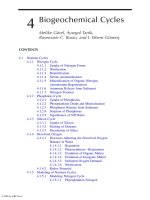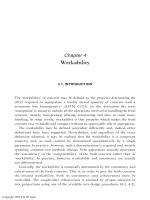Mercury Hazards to Living Organisms - Chapter 4 docx
Bạn đang xem bản rút gọn của tài liệu. Xem và tải ngay bản đầy đủ của tài liệu tại đây (145.57 KB, 7 trang )
37
C
HAPTER
4
Mercury Poisoning and Treatment
The toxicity of mercury has been recognized since antiquity (Hook and Hewitt, 1986). No other
metal demonstrates the diversity of effects caused by different biochemical forms than does mercury
(Goyer, 1986). Toxicologically, there are three forms of mercury: (1) elemental mercury,
(2) inorganic mercury compounds, and (3) organomercurials (Goyer, 1986). Among the various
forms of mercury and its compounds, elemental mercury in the form of vapor, mercuric mercury,
and methylmercury have the greatest toxicological potential (Satoh, 1995). Metallic or elemental
mercury volatilizes to mercury vapor at ambient air temperatures, and most human exposure is by
inhalation. Mercury vapor is lipid soluble, readily diffuses across the alveolar membranes, and
concentrates in erythrocytes and the central nervous system. Inorganic mercury salts can be divalent
(mercuric) or monovalent (mercurous). Gastrointestinal (GI) absorption of inorganic salts of mer-
cury from food is less than 15.0% in mice and about 7.0%
in a study of human volunteers; however,
methylmercury absorption in the GI tract is 90.0 to 95.0%. Methylmercury, when compared to
inorganic mercury compounds, is about 5 times more soluble in erythrocytes than in plasma, and
about 250 times more abundant in hair than in blood (Goyer, 1986).
4.1 POISONING
The primary mode of action of both inorganic and organic mercury compounds is associated with
interference of membrane permeability and enzyme reactions through binding of mercuric ion to
sulfhydryl groups, although organomercurials can penetrate membranes more readily (Norton, 1986).
Early accounts of acute and chronic mercury poisoning and their treatment follow (Anon., 1948);
however, it is cautioned that treatment should be under the guidance of a physician.
4.1.1 Elemental Mercury
Metallic or elemental mercury volatilizes to mercury vapor at ambient air temperatures, and most
human exposure is by way of inhalation (Goyer, 1986). The saturated vapor pressure at 20.0
°
C is
13.2 mg/m
3
. This value far exceeds the threshold limited value (TLV) of 0.05 mg/m
3
; accordingly,
mercury intoxication due to inhalation of the vapor readily occurs in various occupational and
environmental situations (Satoh, 1995). Mercury vapor readily diffuses across the alveolar mem-
brane and is lipid soluble so that it has an affinity for the central nervous system and red blood
cells. Metallic mercury, unlike mercury vapor, is only slowly absorbed by the GI tract (0.01%) at
a rate related to the vaporization of the elemental mercury and is of negligible toxicological
significance (Goyer, 1986).
© 2006 by Taylor & Francis Group, LLC
38 MERCURY HAZARDS TO LIVING ORGANISMS
Inhaled mercury vapor (Hg
o
) is readily oxidized via the catalase–H
2
O
2
complex and converted
to Hg
2+
, mainly in liver and erythrocytes (Satoh, 1995). Although this reaction is rapid, some Hg
o
crosses the blood–brain barrier and accumulates to a greater extent than does Hg
2+
after ionic
mercury exposure. Because Hg
2+
is reduced to Hg
o
, there is probably an oxidation-reduction cycle
of mercury in the body (Satoh, 1995).
In typical Hg
o
vapor poisonings, excessive bronchitis and bronchiolitis occur within a few hours
after heavy exposure, that is, direct inhalation of mercury vapor generated by heating metallic
mercury (Satoh, 1995). This is followed by pneumonitis and respiratory distress, excitability, and
tremors. If the amount inhaled is sufficiently large, renal failure will develop. In one Japanese
factory producing sulfuric acid using Hg
o
in the process, a few of the workers died of respiratory
distress associated with renal failure (Satoh, 1995). Moderate and repeated exposure results in
classical mercury poisoning (Satoh, 1995). Inhalation of mercury vapor, if not fatal, is associated
with an acute, corrosive bronchitis, interstitial pneumonitis, tremors, and increased excitability
(Goyer, 1986). With chronic exposure to mercury vapor, the major effects are on the central nervous
system. Early signs are nonspecific and have been termed “micromercurialism” or “asthenic-
vegetative syndrome” (Goyer, 1986). Micromercurialism is characterized by weakness, fatigue,
anorexia, weight loss, and GI disturbance (Satoh, 1995). This syndrome is characterized clinically
by at least three of the following: tremors, thyroid enlargement, increased radioiodine uptake by
thyroid, tachycardia, unstable pulse, dermographism, gingivitis, changes in blood chemistry, and
increased excretion of mercury in urine (Goyer, 1986). With increasing exposure, the symptoms
include tremors of the fingers, eyelids, and lips, and may progress to generalized trembling of the
entire body and violent chronic spasms of the arms and legs. This is accompanied by changes in
personality and behavior, with loss of memory, increased excitability, severe depression, delirium,
and hallucination. Another characteristic feature of mercury toxicity is severe salivation (Goyer,
1986). Tremors, increased excitability, and gingivitis have been recognized historically as the major
manifestation of mercury poisoning from inhalation of mercury vapor and exposure in the fur, felt,
and hat industry to mercuric nitrate (Goldwater, 1972).
Effects of mercury vapor exposure prevail long after cessation of exposure, although typical
symptoms such as tremors, gingivitis, and salivation usually disappear quickly (Satoh, 1995).
Residual effects due to previous exposure have been documented in workers with a peak urinary
mercury concentration greater than 0.6 mg/L; neurobehavioral disturbances were observed in these
workers 20 to 35 years post exposure (Satoh, 1995).
4.1.2 Inorganic Mercurials
Inorganic mercury salts can be divalent (mercuric) or monovalent (mercurous). Chronic exposure
to low levels of inorganic mercury compounds is associated with psychological changes including
abnormal irritability (erethismas mercurialis), colored mercury compounds in the anterior lens
capsule of the eye (mercurialentis), tremors, and excessive salivation (Norton, 1986). Inorganic
forms of mercury are corrosive and produce symptoms that include metallic taste, burning, irritation,
salivation, vomiting, diarrhea, upper GI tract edema, abdominal pain, and hemorrhage (Rumack
and Lovejoy, 1986). These effects are seen acutely and may subside with subsequent lower GI tract
ulceration. Large ingestion of the mercurial salts may produce kidney ingestion, such as nephrosis,
oliguria, and anuria (Rumack and Lovejoy, 1986).
4.1.2.1 Mercuric Mercury
Acute poisoning by mercurials usually occurs in the case of mercuric perchlorides, with intense
gastrointestinal inflammation, vomiting, diarrhea, and extreme collapse. Treatment is usually with
albumin, which forms an insoluble compound with the perchloride (Anon., 1948). Chronic poison-
ing, or mercurialism, is marked by tenderness of the teeth while eating and offensive breath. Later,
© 2006 by Taylor & Francis Group, LLC
MERCURY POISONING AND TREATMENT 39
the gums become inflamed, salivary glands are swollen and tender, and saliva pours from the mouth.
The teeth may become loose and fall out. The symptoms are aggravated until the tongue and mouth
ulcerate, the jaw bone necroses, hemorrhages occur in various parts of the body, and death results
from anemia, septic inflammation, or exhaustion. Treatment includes administration of potassium
iodide in low, repeated doses (Anon., 1948).
Chronic exposure to low levels of inorganic mercuric compounds produces tremors, excess
salivation, and psychological changes characterized by irritability and excitement (Norton, 1986).
Collectively, this is often described as the “mad hatter syndrome” (Rumack and Lovejoy, 1986).
Mercuric mercury (Hg
2+
) is a potentially toxic chemical, although it is poorly absorbed by the GI
tract and other body parts (Satoh, 1995). Accidental or suicidal ingestion of mercuric chloride or
other mercuric salts produces corrosive ulceration, bleeding, necrosis of the intestinal tract and is
usually accompanied by shock and circulatory collapse (Goyer, 1986). If the patient survives the
gastrointestinal damage, renal failure may occur within 24 hours owing to necrosis of the proximal
tubular epithelium followed by diminished secretion of urine and kidney pathology. These may be
followed by ultrastructural changes consistent with irreversible cell injury. Regeneration of the
tubular lining is possible if the patient can be maintained by dialysis (Goyer, 1986).
The pathogenesis of chronic mercury kidney damage has two phases: an early phase with
antibasement membrane glomerulonephritis, followed by a superimposed immune-complex glom-
erulonephritis (Roman-Franco et al., 1978). The pathogenesis of the nephropathy in humans appears
similar, although early glomerular nephritis may progress to an interstitial immune-complex nephri-
tis (Tubbs et al., 1982). Injection of mercuric chloride produces necrosis of kidney epithelium
(Gritzka and Trump, 1968). Cellular changes include fragmentation of the plasma membrane,
disruption of cytoplasmic membranes, loss of ribosomes, and mitochondrial swelling; however, all
of these changes are associated with renal cell necrosis from a variety of insults. High doses of
mercuric chloride are directly toxic to renal tubular lining cells and chronic low-level doses to mercuric
salts may induce an immunologic glomerular disease that is the most common form of mercury-
induced nephropathy. Chronic mercury-induced kidney damage seldom occurs in the absence of
detectable damage to the nervous system (Gritzka and Trump, 1968). Although kidneys contain
the highest concentrations of mercury following exposure to inorganic mercury salts and mercury
vapor, it is emphasized that organomercurials concentrate in the posterior cortex of the brain (Goyer,
1986).
4.1.2.2 Mercurous Mercury
Mercurous (Hg
+
) mercury compounds are unstable and easily break down to Hg
o
and Hg
2+
(Satoh,
1995). Mercurous compounds are less corrosive and less toxic than mercuric compounds, probably
because they are less soluble (Rumack and Lovejoy, 1986).
Calomel — a mercurous chloride-containing powder with a long history of medical use — is
known to be responsible for acrodynia or “pink-disease” in children when used as a teething powder
(Matheson et al., 1980). This is probably a hypersensitivity response by skin to mercurous salts,
producing vasodilation, hyperkeratosis, and excessive sweating. Afflicted children had fever, pink-
colored rashes, swollen spleen and lymph nodes, and hyperkeratosis and swelling of fingers. Effects
were independent of dose and are thought to be a hypersensitivity reaction (Matheson et al., 1980).
4.1.3 Organomercurials
Among the organomercurials, alkylmercurials — especially methylmercurials (CH
3
Hg
+
) — are the
most environmentally and ecologically significant (Satoh, 1995). Methylmercury is naturally pro-
duced from inorganic mercury by microbial activity; methylmercurials are lipid soluble and readily
cross blood–brain and placental barriers (Satoh, 1995). The sensitivity of the developing brain to
methylmercury is due to placental transfer of lipophilic methylmercury to the central nervous system
© 2006 by Taylor & Francis Group, LLC
40 MERCURY HAZARDS TO LIVING ORGANISMS
(CNS) (Campbell et al., 1992). The blood–brain barrier is incomplete during the first year of life
in humans, and methylmercury can cross this barrier during that time (Rodier, 1995). Phenylmer-
curials (C
6
H
5
Hg
+
) and methoxyethyl mercurials (CH
3
OC
2
H
4
Hg
+
) have been used as fungicides and
pesticides and readily transform into inorganic mercurials in living organisms with toxic properties
similar to those of inorganic mercurials (Satoh, 1995).
Ingestion of organomercurials, such as ethylmercury, may produce symptoms of nausea, vom-
iting, abdominal pain, and diarrhea, but in most cases the main toxicity is neurologic involvement
presenting with paresthesias, visual disturbances, mental disturbances, hallucinations, ataxia, hear-
ing defects, stupor, coma, and death (Rumack and Lovejoy, 1986). Symptoms may occur for several
weeks after exposure. Exposure and poisoning can occur after ingestion of mercury-contaminated
seafoods, grains, or inhalation of vaporized organomercurials (Rumack and Lovejoy, 1986).
The toxic signs of alkylmercury compounds, such as methylmercury, are different than those
of inorganic mercurials owing to greater penetration of the organomercurials into the brain (Norton,
1986). Methylmercury causes necrosis of the granule cell layer of the cerebellum, which is asso-
ciated with carbohydrate metabolism and kidney disorders. Focal atrophy of the cortex, with sensory
disturbances, ataxia, and dysarthria, is found after methylmercury intoxication. The emotional
changes and autonomous nervous system involvement with inorganic mercury compounds are not
seen with organomercurials (Norton, 1986).
Sensory nerve fibers are selectively damaged (Norton, 1986). The primary mode of action of
both inorganic and organic mercury compounds may be interference with membrane permeability
and enzyme actions by binding of mercuric ion to sulfhydryl groups. Small neurons in the CNS
are more likely to be damaged than large neurons in the same area by methylmercury (Norton,
1986). The major clinical features of methylmercury toxicity are neurologic, consisting of pares-
thesia, ataxia, dysarthria, and deafness, appearing in that order (Roizin et al., 1977). The main
pathologic features include degeneration and necrosis of neurons in focal areas of the cerebral
cortex and in the granular layer of the cerebellum. Studies of both inorganic- and organic-mercury-
related neuropathy show degeneration of primary sensory ganglion cells. Lesion distribution in the
CNS suggests that mercury damages small nerve cells in the cerebellum and visual cortex (Roizin
et al., 1977). Methylmercuric chloride, as an environmental pollutant, has produced renal damage
in humans and animals through inhibition of mitochondrial and other enzyme systems (Hook and
Hewitt, 1986).
4.2 MERCURY TREATMENT
Treatment of mercury-poisoned victims is complex, and should be supervised by a physician.
Therapy of mercury poisoning is directed toward lowering the concentration of mercury at the
critical organ or site of injury (Berlin, 1979). For the most severe cases, particularly with acute
renal failure, hemodialysis together with infusion of mercury-chelating agents such as cysteine and
penicillamine is warranted. For less severe cases of inorganic mercury poisoning, chelation with
BAL (dimercaprol) is recommended. Chelation therapy, however, is not effective for poisoning
with organomercurials. In those cases, oral administration of a nonabsorbable thiol resin that binds
mercury and enhances intestinal excretion, or surgical establishment of gallbladder drainage have
proven satisfactory (Berlin, 1979).
Treatment usually consists of emesis or lavage, followed by administration of activated charcoal
and a saline cathartic (Rumack and Lovejoy, 1986). Cow’s milk may be given to help precipitate the
mercury compound. Blood and urine levels of mercury may be useful in determining whether chelating
agents, such as D-penicillamine or BAL (dimercaprol) should be administered. D-penicillamine is
given at 250.0 mg orally, four times daily in adults. For children, D-penicillamine is given at
100.0 mg/kg body weight daily to a maximum recommended dose of 1000 mg daily for 3 to 10 days
© 2006 by Taylor & Francis Group, LLC
MERCURY POISONING AND TREATMENT 41
with continuous monitoring of mercury urinary excretion. In patients unable to tolerate penicil-
lamine, BAL can be administered at a dose of 3.0 to 5.0 mg/kg body weight (BW) every 4 h by
deep intramuscular (im) injection for the first 2 days, then 2.5 to 3.0 mg/kg BW im every 6 h for
2 days, followed by 2.5 to 3.0 mg/kg BW im every 12 h for 1 week. Adverse reactions associated
with BAL, such as skin eruptions (urticaria), can often be controlled with antihistamines such as
diphenylhydramine. The development of renal failure contraindicates use of penicillamine because
the kidney is the main excretory route for penicillamine. BAL therapy can be used cautiously
despite renal failure because BAL is excreted in the bile; however, BAL toxicity, which consists
of fever, rash, hypertension, and CNS stimulation must be closely monitored. Dialysis is not
recommended because it does not remove chelated or free mercury (Rumack and Lovejoy, 1986).
Mercury-antagonistic and mercury-protectant drugs and compounds now include 2,3-dimercap-
topropanol, polythiol resins, selenium salts, thiamin, vitamin E, metallothionein-like proteins, and
sulfhydryl agents (Magos and Webb, 1979; Elhassani, 1983; Siegel et al., 1991; USPHS, 1994;
Caurent et al., 1996). Thiols (R-SH), which compete with mercury for protein binding sites, are
the most important antagonists of inorganic mercury salts, and have been used extensively in
attempts to counteract mercury poisoning in humans (Das et al., 1982). Thiamin was the most
effective of the Group VIB derivatives (which includes sulfur, selenium, and tellurium) in protecting
against organomercury poisoning in higher animals (Siegel et al., 1991). The protective action of
selenium (Se) against adverse or lethal effects induced by inorganic or organic mercury salts is
documented for algae, aquatic invertebrates, fish, birds, and mammals (Magos and Webb, 1979;
Heisinger, 1979; Chang et al., 1981; Lawrence and Holoka, 1981; Das et al., 1982; Gotsis, 1982;
Satoh et al., 1985; Eisler, 1987; Goede and Wolterbeek, 1994; Paulsson and Lundbergh, 1989; USPHS,
1994; Caurent et al., 1996; Kim et al., 1996a, 1996b). For example, selenium, as sodium selenite,
that was introduced into a nonacidified mercury-contaminated lake in Sweden to concentrations of
3.0 to 5.0
µg Se/L (from 0.4 µg Se/L) and sustained at this level for 3 years resulted in declines
of 50.0 to 85.0% in mercury concentrations in fish muscle (Paulsson and Lundbergh, 1989). The
mercury-protective effect of selenium is attributed to competition by selenium for mercury-binding
sites associated with toxicity, formation of a Hg-Se complex that diverts mercury from sensitive
targets, and prevention of oxidative damage by increasing the amount of selenium available to the
selenium-dependent enzyme glutathione peroxidase (USPHS, 1994). In seabirds, an equivalent
molar ratio of 1:1 between total mercury and selenium was found in livers of individual seabirds
that contained more than 100.0 mg Hg/kg DW; this relation was unclear in other individuals, which
had relatively low mercury levels (Kim et al., 1996a, 1996b). The selenium-protective mechanism
in birds is explained by a strong binding between mercury and selenium, possibly by the formation
of a selenocystamine–methylmercury complex (CH
3
HgSeCH
2
CH
2
NH
3
+
), mercury binding to sele-
nocysteine residues (CH
3
HgSeCH
2
CH(NH
3
)(COO)•H
2
O), the formation of insoluble mercuric
selenide (HgSe), or binding of mercury to SeH residues of selenoproteins, notably metallothioneins
with thiols replaced by SeH (Goede and Wolterbeek, 1994). However, high selenium concentrations
in tissues of marine wading birds do not have their origin in elevated levels of mercury. The Se:Hg
ratio in marine wading birds from the Wadden Sea is 32:1 and greatly exceeds the 1:1 ratio found
when selenium is accumulated to detoxify mercury (Goede and Wolterbeek, 1994). In marine
mammals and humans, selenium and mercury concentrations are closely related, almost linearly
in a 1:1 molar ratio (Eisler, 1987). The molar ratio between mercury and selenium in marine
mammals suggests that the major mechanism of detoxification is through the formation of a complex
Hg–Se that leads to mercury demethylation (Caurent et al., 1996). The site of this process is the
liver in which mercury appeared mainly as inorganic; whereas in the muscle, the percent of organic
to total mercury was much higher. Detoxification is limited in lactating female whales, and some-
times in all the individuals of one school (Caurent et al., 1996). Selenium does not, however, protect
against mercury-induced birth defects, such as cleft palate in mice (USPHS, 1994). It is clear that
more research is needed on mercury protectants.
© 2006 by Taylor & Francis Group, LLC
42 MERCURY HAZARDS TO LIVING ORGANISMS
4.3 SUMMARY
Both inorganic and organomercurials interfere with membrane permeability and enzyme reactions
through binding of mercuric ion to sulfhydryl groups; organomercurials usually penetrate mem-
branes more readily. Symptoms of acute and chronic mercury poisoning caused by elemental
mercury, mercuric mercury, mercurous mercury, and organomercurial compounds are listed, mech-
anisms of action discussed, and treatment regimes prescribed. For elemental mercury, inhalation
of Hg
o
is the primary toxicological route. Inhaled Hg
o
vapor is readily oxidized within the body,
mainly in liver and erythrocytes, and converted to Hg
2+
. Neurobehavioral disturbances were
observed in some Hg
o
vapor poisoning cases 20 to 35 years after exposure. For inorganic mercuric
compounds, exposure routes include inhalation and ingestion, with primary damage to the renal
system. Mercurous (Hg
+
) mercury compounds are unstable and degrade to Hg
o
and Hg
2+
. Mercurous
compounds are less corrosive and less toxic than mercuric compounds and this could be associated
with their comparatively low solubility. Among the organomercurials, methylmercury compounds
(CH
3
Hg
+
) are the most significant toxicologically because they are produced naturally from inor-
ganic mercury by microbial activity and are lipid soluble, thus readily crossing blood–brain and
placental barriers. Ingestion is the main route of administration for methylmercurials and the
primary target organs are brain and other neurologic tissues.
Treatment of mercury-poisoned victims is complex and should be supervised by a physician.
Therapy is directed to lowering the mercury concentration at the critical organ or site of injury
through emesis, lavage, cathartics, administration of activated charcoal and various mercury chelat-
ing agents, and — in the most severe cases — dialysis. The development of mercury-antagonistic
and mercury-protectant drugs is proceeding, and some already available have been used to treat
cases of inorganic mercury poisoning (thiols) and organomercurial poisoning (thiamin, and selenium-,
sulfur-, and tellurium-containing drugs).
REFERENCES
Anon. 1948. Mercury, Encylop. Brittanica, 15, 269–272.
Berlin, M. 1979. Mercury. In L. Friberg, G.F. Nordberg, and C. Nordman (Eds.), Handbook on the Toxicology
of Metals, p. 503–530. Elsevier/North-Holland Biomedical Press, New York.
Campbell, D, M. Gonzales, and J.B. Sullivan Jr. 1992. Mercury. Pages 824–833 in J.B. Sullivan Jr. and G.R.
Krieger (Eds.), Materials Toxicology — Clinical Principles of Environmental Health, p. 824–833.
Williams and Wilkins, Baltimore, MD.
Caurant, F., M. Navarro, and J.C. Amiard. 1996. Mercury in pilot whales: possible limits to the detoxification
process, Sci. Total Environ., 186, 95–104.
Chang, P.S.S., D.F. Malley, N.E. Strange, and J.F. Klaverkamp. 1981. The effects of low pH, selenium and
calcium on the bioaccumulation of
203
Hg by seven tissues of the crayfish, Orconectes virilis, Canad.
Tech. Rep. Fish. Aquat. Sci., 1151, 45–67.
Das, S.K., A. Sharma, and G. Talukder. 1982. Effects of mercury on cellular systems in mammals — a review,
Nucleus (Calcutta), 25, 193–230.
Eisler, R. 1987. Mercury hazards to fish, wildlife, and invertebrates: a synoptic review, U. S. Fish Wildl. Serv.
Biol. Rep., 85(1.10), 1–90.
Elhassani, S.B. 1983. The many faces of methylmercury poisoning, J. Toxicol., 19, 875–906.
Goede, A.A. and H.T. Wolterbeek. 1994. Have high selenium concentrations in wading birds their origin in
mercury?, Sci. Total Environ., 144, 247–253.
Goldwater, L.J. 1972. In Mercury: A History of Quicksilver, p. 270–277. York Press, Baltimore, MD.
Gotsis, O. 1982. Combined effects selenium/mercury and selenium/copper on the cell population of the alga
Dunaliella minuta, Mar. Biol., 71, 217–222.
Goyer, R.A. 1986. Toxic effects of metals. In C.D. Klaassen, M.O. Amdur, and J. Doull (Eds.), Casarett and
Doull’s Toxicology, third edition, p. 582–635. Macmillan, New York.
© 2006 by Taylor & Francis Group, LLC
MERCURY POISONING AND TREATMENT 43
Gritzka, T.L. and B.F. Trump. 1968. Renal tubular lesions caused by mercuric chloride, Am. J. Pathol., 52,
1225–1227.
Heisinger, J.F., C.D. Hansen, and J.H. Kim. 1979. Effect of selenium dioxide on the accumulation and acute
toxicity of mercuric chloride in goldfish, Arch. Environ. Contam. Toxicol., 8, 279–283.
Hook, J.B. and W.R. Hewitt. 1986. Toxic responses of the kidney. In C.D. Klaassen, M.O. Amdur, and J. Doull
(Eds.), Casarett and Doull’s Toxicology, third edition, p. 310–329. Macmillan, New York.
Kim, E.Y., K. Saeki, S. Tanabe, H. Tanaka, and R. Tatsukawa. 1996a. Specific accumulation of mercury and
selenium in seabirds, Environ. Pollut., 94, 261–265.
Kim, E.Y., T. Murakami, K. Saeki, and R. Tatsukawa. 1996b. Mercury levels and its chemical form in tissues
and organs of seabirds, Arch. Environ. Contam. Toxicol., 30, 259–266.
Lawrence, S.G. and M.H. Holoka. 1981. Effect of selenium on impounded zooplankton in a mercury con-
taminated lake, Can. Tech. Rep. Fish. Aquat. Sci., 1151, 83–92.
Magos, L. and M. Webb. 1979. Synergism and antagonism in the toxicology of mercury. In J.O. Nriagu (Ed.),
The Biogeochemistry of Mercury in the Environment, p. 581–599. Elsevier/North-Holland Biomedical
Press, New York.
Matheson, D.S., T.W. Clarkson, and E.W. Gelfand. 1980. Mercury toxicity (acrodynia) induced by long-term
injection of gamma globulin, J. Pediatr., 97, 153–155.
Norton, S. 1986. Toxic responses of the central nervous system. In C.D. Klaassen, M.O. Amdur, and J. Doull
(Eds.), Casarett and Doull’s Toxicology, third edition, p. 359–386. Macmillan, New York.
Paulsson, K. and K. Lundbergh. 1989. The selenium method for treatment of lakes for elevated levels of
mercury in fish, Sci. Total Environ., 87/88, 495–507.
Rodier, P.M. 1995. Developing brain as a target of toxicity, Environ. Health Perspect., 103 (Suppl. 6), S73–S76.
Roizin, L., H. Shiraki, and N. Grceric. 1977. NeuroToxicology, Volume 1. Raven Press, New York. 658 pp.
Roman-Franco, A.A., M. Twirello, B. Abini, and E. Ossi. 1978. Anti-basement membrane antibodies with
antigen-antibody complexes in rabbits injected with mercuric chloride, Clin. Immunol. Immunopathol.,
9, 404–411.
Rumack, B.H. and F.H. Lovejoy Jr. 1986. Clinical toxicology. Pages 879–901 in C.D. Klaassen, M.O. Amdur,
and J. Doull (Eds.). Casarett and Doull’s Toxicology, third edition. Macmillan, New York.
Satoh, H. 1995. Toxicological properties and metabolism of mercury; with an emphasis on a possible method
for estimating residual amounts of mercury in the body. In Proceedings of the International Workshop
on “Environmental Mercury Pollution and its Health Effects in Amazon River Basin,” p. 106–112,
Rio de Janeiro, 30 November–2 December 1994. Published by National Institute for Minamata
Disease, Minamata City, Kumamoto 867, Japan.
Satoh, H., N. Yasuda, and S. Shimai. 1985. Development of reflexes in neonatal mice prenatally exposed to
methylmercury and selenite, Toxicol. Lett., 25, 199–203.
Siegel, B.Z., S.M. Siegel, T. Correa, C. Dagan, G. Galvez, L. Leeloy, A. Padua, and E. Yaeger. 1991. The
protection of invertebrates, fish, and vascular plants against inorganic mercury poisoning by sulfur
and selenium derivatives, Arch. Environ. Contam. Toxicol., 20, 241–246.
Tubbs, R.R., G.N. Gephardt, J.T. McMahon, M.C. Phol, D.G. Vidt, S.A. Barenberg, and R. Valenzuela. 1982.
Membraneous glomerulonephritis associated with industrial mercury exposure, Am. J. Clin. Pathol.,
77, 409–413.
U.S. Public Health Service (USPHS). 1994. Toxicological Profile for Mercury (Update), TP-93/10. U.S. PHS,
Agen. Toxic Substances Dis. Registry, Atlanta, GA. 366 pp.
© 2006 by Taylor & Francis Group, LLC

